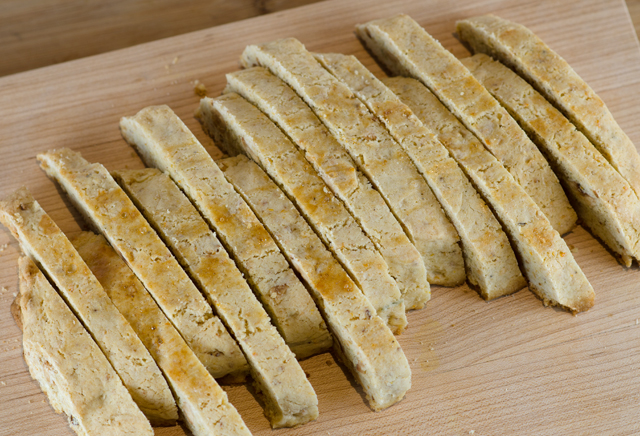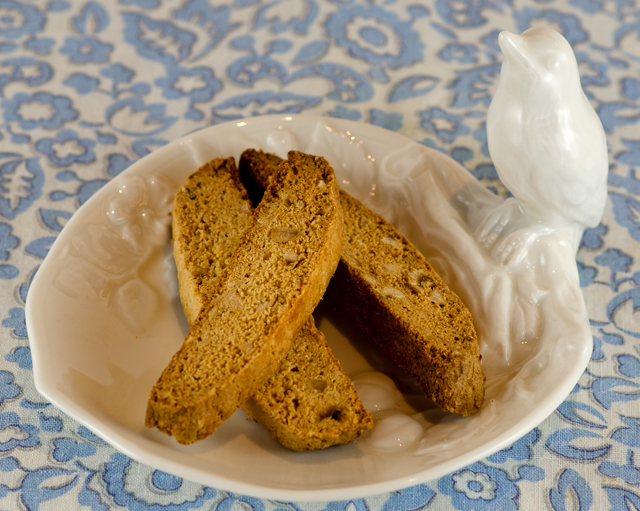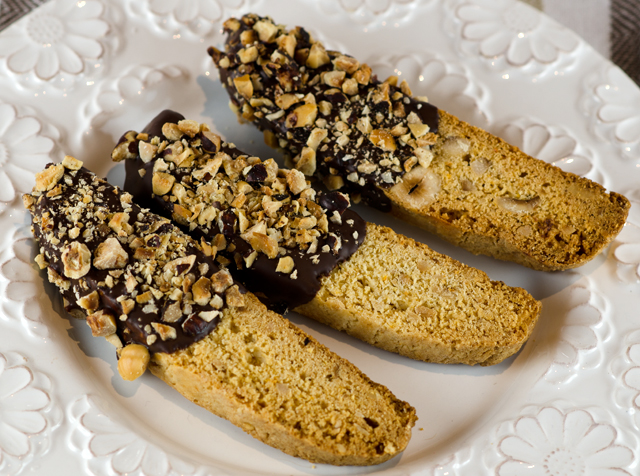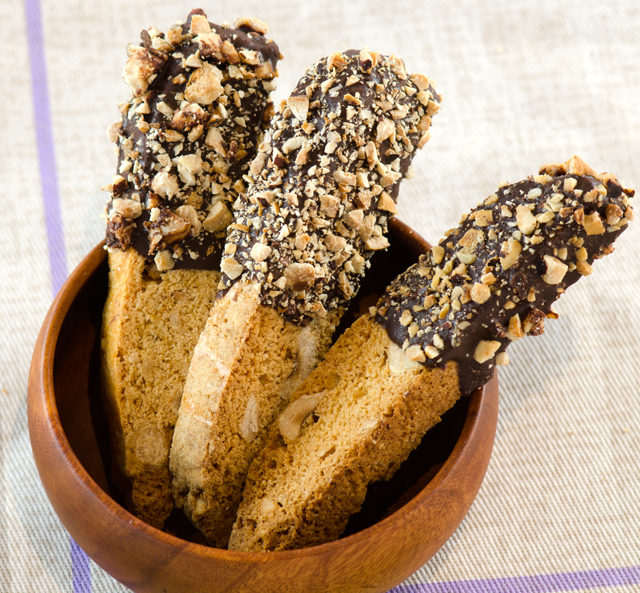 When it comes to cookies, at the top of the list of my personal favorites is biscotti. Almond biscotti were on the menu for a light nibble after our seven fishes dinner and I am making hazelnut orange biscotti for a pasta making dinner this weekend. Biscotti originated in medieval Italy as a long shelf life food for Roman soldiers and travelers. It is thought that both Christopher Columbus and Marco Polo relied on biscotti for sustenance on their long journeys. The word derives from bis, Latin for twice and cotto for baked. The basic recipe is simple, dough is formed into logs, baked and cooled, sliced and baked again.
When it comes to cookies, at the top of the list of my personal favorites is biscotti. Almond biscotti were on the menu for a light nibble after our seven fishes dinner and I am making hazelnut orange biscotti for a pasta making dinner this weekend. Biscotti originated in medieval Italy as a long shelf life food for Roman soldiers and travelers. It is thought that both Christopher Columbus and Marco Polo relied on biscotti for sustenance on their long journeys. The word derives from bis, Latin for twice and cotto for baked. The basic recipe is simple, dough is formed into logs, baked and cooled, sliced and baked again.
Hazelnuts, are also known as filberts. Twenty five percent of the world’s hazelnut production goes to the manufacturing of Nutella, a very popular creamy chocolate hazelnut spread. Hazelnuts may a bit harder to find than, lets say walnuts or almonds, but many large supermarkets stock them. When I can I like to buy nuts from a bulk bin to ensure their freshness. I baked the hazelnuts in a 350°F oven for 10 minutes, shaking the pan every few minutes and rotating the pan each time. The nuts will start to exude their oil and your kitchen will smell heavenly. Transfer lightly toasted nuts to a tea towel to cool, then fold over half the towel and rub gently, back and forth to remove as much skin as possible. Don’t worry if some of the nuts refuse to be skinned, the toasting has made the tannins in the skin less bitter and will add some color and depth of flavor. The nuts should only be lightly toasted since they will be going back into the oven to be baked again in the biscotti. Some of the toasted nuts are finely ground and added to the flour mixture, the rest are coarsely chopped and are folded in at the end of the recipe. Be sure not to take the finely ground nuts too far or you may be left with hazelnut butter.
A little bit of fresh rosemary is included with the dry ingredients. If you don’t have access to fresh, a smaller amount of dried will do or you could eliminate it all together. Flour, rosemary, baking powder and salt are combined in bowl of a food processor. Be sure to check the expiration date on your baking powder. If the date has passed or is soon approaching, there is a simple test you can do to see if it will still do the job. Baking powder is a chemical leavener that reacts to temperature so just drop a little into a glass of hot water. If it bubbles up, you are good to go! Process these ingredients then transfer to a bowl.
Two eggs are now added to the empty bowl and processed until light in color and doubled in volume. I improvised a paper cone for the feed tube to make it easier to add the sugar gradually. This was much neater than using a measuring cup. The melted butter, orange zest, orange liqueur and vanilla extract are added and processed until combined. The wet ingredients are transferred to a bowl and the flour mixture and hazelnuts are gently folded in. I find that a large bowl and the largest spatula you have will make this easier. Lift up from the bottom of the bowl and fold over. Whatever you do, resist the temptation to stir the ingredients!
Flour your hands before forming the dough into two logs the size of the 8×3 inch template. Brush the logs with egg white wash, this will give the cookies sheen. Bake the logs for about 25 minutes, cool and cut into 1/2′ slices. I find a serrated knife works best for this. Time for the cookies to go back into the oven. Bake cookies until crisp and golden brown on both sides. Cool completely before serving. The cookies will be great at this point but you can also take them one step further by dipping the cookies in bittersweet chocolate and sprinkling with toasted hazelnuts.
Oh, by the way, biscotti is the plural form of the word, like a batch of cookies. If you only have one left it’s a biscotto and it’s time to fill the cookie jar again.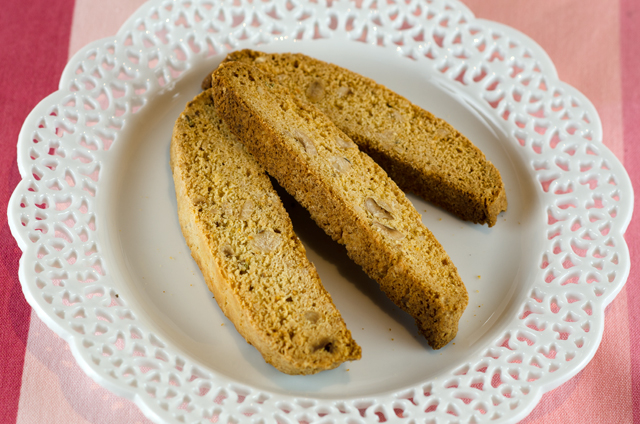
Hazelnut-Orange Biscotti
from Cooks Illustrated November 2012
Makes 30 cookies
Ingredients
- 1 1/4c hazelnuts, lightly toasted and skinned
- 1 3/4c all purpose flour
- 1/2t finely minced dried rosemary
- 2t baking powder
- 1/4t table salt
- 2 large eggs, plus 1 egg white beaten with a pinch of salt
- 1c granulated sugar
- 4T unsalted butter, melted and cooled
- 1T grated orange zest
- 1 1/2t orange flavored liqueur (Grand Marnier, Triple Sec)
- 1/2t vanilla extract
- Vegetable oil spray
Directions
- Adjust oven rack to middle position and heat oven to 325°F. Using a ruler and marker, draw two 8 by 3-inch rectangles, spaced 4 inches apart on a piece of parchment paper. Grease baking sheet and place parchment on it, ink side down.
- Pulse 1 cup hazelnuts in food processor until coarsely chopped, 8 to 10 pulses; transfer to a bowl and set aside. Process remaining 1/4 cup hazelnuts in food processor until finely ground, about 45 seconds.
- Add flour, rosemary, baking powder, and salt; process to combine, about 15 seconds. Transfer the flour mixture to a bowl.
- Process 2 eggs in the now empty food processor until lightened in color and almost doubled in volume, about 3 minutes. With processor running, slowly add sugar until thoroughly combined, about 15 seconds. Add melted butter, orange zest, orange liqueur and vanilla; process until combined, about 10 seconds.
- Transfer egg mixture to a large bowl. Sprinkle half of the flour mixture over the egg mixture and, using a large spatula, gently fold until just combined. Add remaining flour mixture and chopped hazelnuts and gently fold until just combined.
- Divide batter in half. Using floured hands, form each half into an 8 by 3 inch rectangle, using the lines on the parchment as a guide. Using a medium rubber spatula lightly coated with spray, smooth the tops and sides of the rectangles. Gently brush the tops of the loaves with the egg white wash. Bake until the loaves are golden and just beginning to crack on top, 25-30 minutes, rotating pan halfway through baking.
-
Let loaves cool on baking sheet for 30 minutes. Transfer loaves to cutting board. Using a serrated knife, slice each loaf on a slight diagonal into 1/2 inch thick slices. Lay slices, cut side down, about 1/4 inch apart on wire rack set in rimmed baking sheet. Bake until crisp and golden brown on both sides, about 30 minutes, flipping slices halfway through baking. Let cool completely before serving. Biscotti can be stored in an airtight container for up to 1 month.
- To further embellish the cookies, melt some bittersweet chocolate, about four ounces in a small pan over another pan of simmering water. This is known as a double boiler. Line a small dish with a sheet of waxed paper to catch the drippings. Hold the cookie in your non dominant hand over the dish. Use a wooden spoon to evenly drizzle melted chocolate over half of the cookie. Then immediately sprinkle some finely chopped hazelnuts on top. Let the chocolate dry thoroughly on a rack over a sheet pan that has been lined with parchment to catch any additional drippings. Store cookies in an airtight container.

